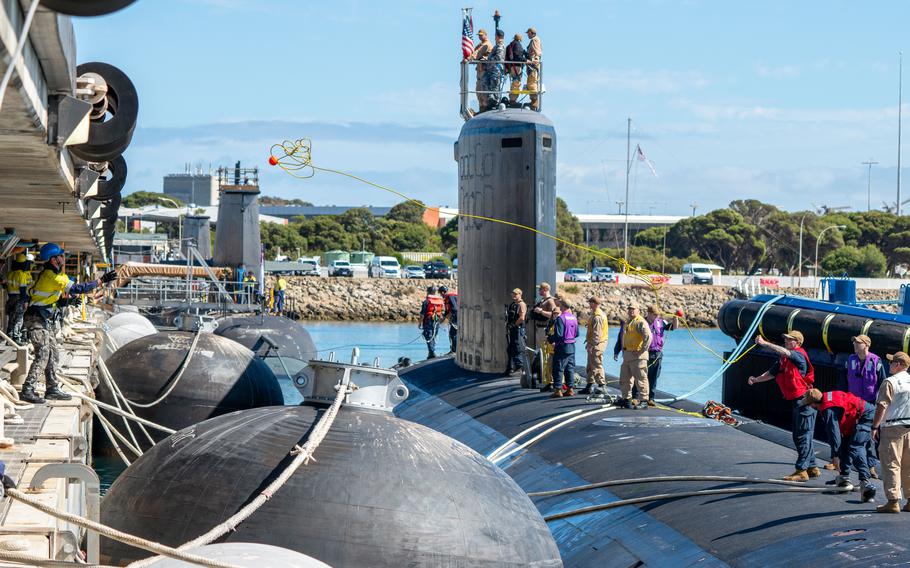
Sailors assigned to the Virginia-class submarine USS Minnesota conduct mooring operations at HMAS Stirling, Western Australia, Australia, on Feb. 25, 2025. (James Cavila/U.S. Navy)
The Trump administration’s ambivalent approach to U.S. alliances has ruffled a lot of feathers, including in the Asia-Pacific. In a sign of disquiet, a number of Asia-Pacific leaders backed out of attending the June NATO summit in The Hague. Likewise, Tokyo recently scrapped a “2+2” summit of defense and foreign ministers with Washington.
Then there are the dark clouds swirling around the AUKUS submarine deal, which joined the capabilities of the U.S., Britain and Australia to build nuclear fast attack submarines (SSNs). AUKUS, which was first announced in fall 2021, is now under review by the Trump administration, with some Pentagon leadership expressing skepticism.
There are real problems with the deal that should be openly discussed and debated. But the United States should still remain a party to AUKUS as a way to share the burden of defense while maintaining the naval balance in the Pacific.
Nuclear submarines are the most important platform for 21st-century naval warfare, so it makes sense to prioritize them as a strategic hedge when the Chinese navy is advancing so rapidly. Nuclear submarines have unparalleled range, speed and stealth. While the Chinese navy is closing the gap in aspects of surface ship design, the U.S. Navy retains a substantial lead in undersea warfare that should be maintained.
In advancing the design and production of these key naval platforms, AUKUS seems set to recapitalize U.S. shipyards with a significant injection of investment funding. The U.S. Navy will also gain additional forward basing opportunities for its SSN fleet in the western Pacific. This will help to diversify U.S. Navy logistics, which are now somewhat concentrated and hence more vulnerable.
The other key advantage of AUKUS is to bring Australia along as a budding submarine power. This is well underway with Royal Australian Navy students training aboard U.S. Navy submarines and graduating from the U.S. Navy Nuclear Power School. Since Australians have fought alongside Americans in nearly every armed conflict over the last century, this effort at long-term collaboration seems like a strong investment in Pacific burden-sharing.
The deal will also spur the enhanced development of the U.K.’s submarine force, which forms a key component of the global maritime balance.
As significant as AUKUS could be to the future of security in the Asia-Pacific, we should openly acknowledge its shortfalls, drawbacks, and even strategic risks.
First and foremost, there’s a scenario where the deal actually decreases U.S. Navy submarine force structure in the medium term as some Virginia-class boats are sold to Australia. Considering that annual attack submarine production stands at about 1.2 per year, far below the goal of two or more boats per annum, there’s a risk that sending these vessels to Australia could degrade U.S. Navy submarine capabilities to some extent in the 2030s. Maintaining focus could also be difficult when a variety of technologies, including some unrelated to undersea warfare, are piled into the sweeping deal.
Besides an overstretched workforce and myriad bureaucratic challenges, AUKUS also faces certain diplomatic and political challenges. Many critics have raised nuclear proliferation concerns. There is a tempting but risky course whereby the pact is expanded to include other allies, such as Canada, which is seeking to reboot its submarine force.
This could inflame yet another critique of AUKUS, which is that it’s simply a group of Anglophone powers seeking to maintain control of Asian waters without including the Asians. Many Southeast Asian countries have expressed concerns over the pact.
Still, these problems are generally manageable. Shipyard recapitalization will likely result in higher production rates down the line. The present slowdown is probably the partial result of U.S. efforts to launch a new class of strategic nuclear submarines, the Columbia-class SSBN, growing pains that should pass in a few years. The diplomatic challenges can be dealt with more skillfully, and this should include seeking to avoid a costly arms race that Beijing is already warning of.
But a larger strategic issue still looms over the project, namely the Taiwan conundrum. It’s worth noting that the shallow bathymetry of the East Asian littoral, particularly the Taiwan Strait, is not conducive to large nuclear submarines. Moreover, an authoritative wargame simulation recently demonstrated that nuclear attack submarines might not be decisive in this scenario due to their small magazines and limited ability to rearm in theater.
Then there’s the obvious point that the Taiwan situation is acute right now. AUKUS submarines might well appear a decade too late.
These strategic issues suggest that AUKUS is no “silver bullet” against China or in favor of Taiwan and should not be treated as such. Moreover, improvements in allied submarine fleets in the 2030s should not come at a cost to U.S. Navy capabilities.
Nevertheless, AUKUS still makes sense as a way to preserve the overall naval balance in the Asia-Pacific in the long run. It’s an affordable and feasible way to share the burdens of defense in an uncertain world and preserve peace in the Pacific for future generations.
Lyle Goldstein is director of the Asia Program at Defense Priorities.